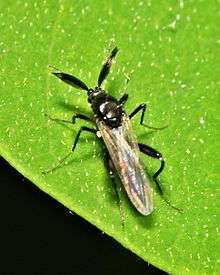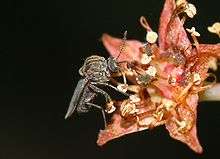Ceratopogonidae
| Ceratopogonidae | |
|---|---|
 | |
| A female biting midge, Culicoides sonorensis | |
| Scientific classification | |
| Kingdom: | Animalia |
| Phylum: | Arthropoda |
| Class: | Insecta |
| Order: | Diptera |
| Suborder: | Nematocera |
| Infraorder: | Culicomorpha |
| Superfamily: | Chironomoidea |
| Family: | Ceratopogonidae |
| Subfamilies | |
Ceratopogonidae, or biting midges, are a family of small flies (1–4 mm long) in the order Diptera. They are also known as no-see-ums, midgies, sand flies, punkies, and others in North America, and sandflies[1] in Australia. They are closely related to the Chironomidae, Simuliidae (or black flies), and Thaumaleidae.

They are found in almost any aquatic or semiaquatic habitat throughout the world, as well as in mountain areas. Females of most species are adapted to suck blood from some kind of host animal. Culicoides, Forcipomyia (Lasiohelea), and Leptoconops suck vertebrate blood. Some Atrichopogon and Forcipomyia species are ectoparasites on larger insects. Dasyhelea species feed exclusively on nectar. Species in other genera are predatory on other small insects. Larvae are always found in some damp location, such as under bark, in rotten wood, compost, mud, stream margins, tree holes, or water-holding plants (i.e., phytotelmata).



Many of the hematophagic (blood-eating) species are pests in beach or mountain habitats. Some other species are important pollinators of tropical crops such as cacao. The blood-sucking species may be vectors of disease-causing viruses, protozoa, or filarial worms. The bite of midges in the genus Culicoides causes an allergic response in equines known as sweet itch. In humans, their bites can cause intensely itchy, red welts that can persist for more than a week. The discomfort arises from a localized allergic reaction to the proteins in their saliva, which can be somewhat alleviated by topical antihistamines.
The smaller members of the family are tiny enough to pass through the apertures in typical window screens. Camping tents are often equipped with extra-fine mesh netting, called no-see-um nets, to keep the pests out.
They are known to spread Tete virus.
See also
- Culicoides impunctatus—known as the Scottish midge, or Highland midge
- Culicoides imicola
References
- Blanton, F.S. and W.W. Wirth. 1979. The sand flies (Culicoides) of Florida (Ceratopogonidae). Arthropods of Florida and Neighboring Land Areas Volume 10. Florida Department of Agriculture and Consumer Services.
- Borkent, A. and W.W. Wirth. 1997. World species of biting midges (Diptera: Ceratopogonidae). Bulletin of the American Museum of Natural History 233: 1–257.
- Clastrier, J. and W.W. Wirth. 1978. The Leptoconops kerteszi complex in North America (Diptera: Ceratopogonidae). United States Department of Agriculture Technical Bulletin Number 1573.
- Downes, J.A. and W.W. Wirth. 1981. Chapter 28: Ceratopogonidae. Pp. 393–421. In: McAlpine, J.F., B.V. Peterson, G.E. Shewell, H.J. Teskey, J.R. Vockeroth, and D.M. Wood. Manual of Nearctic Diptera, Volume 1. Agriculture Canada Monograph 27.
- Hendry, George. Midges in Scotland 4th Edition, Mercat Press, Edinburgh, 2003 ISBN 1-84183-062-3
- Mullen, G.R. and L.J. Hribar. 1988. Biology and feeding behavior of ceratopogonid larvae (Diptera: Ceratopogonidae) in North America. Bulletin of the Society for Vector Ecology 13: 60–81.
- Wirth, W.W. and F.S. Blanton. 1974. The West Indian sandflies of the genus Culicoides (Diptera: Ceratopogonidae). United States Department of Agriculture Technical Bulletin Number 1474.
- Wirth, W.W. and W.L. Grogan, Jr. 1988. The Predaceous Midges of the World (Diptera: Ceratopogonidae; Tribe Ceratopogonini). Flora and Fauna Handbook Number 4. E.J. Brill Publishers, Leiden. xv + 160 pp.
- Wirth, W.W., N.C. Ratanaworabhan, and D.H. Messersmith. 1977. Natural history of Plummers Island, Maryland. XXII. Biting midges (Diptera: Ceratopogonidae). 1. Introduction and key to genera. Proceedings of the Biological Society of Washington, 90(3): 615–647.
External links
- British insects: the families of Diptera – Delta guides, Biodiversity and Biological Collections
- Ceratopogonidae – AAFC, Government of Canada
- The Ceratopogonidae – Inbio Site, Instituto Nacional de Biodiversidad
- Ceratopogonid Web Page – Belmont University
- Biting midges on the UF / IFAS Featured Creatures Web site
- Flying Teeth Spain Buddy Website
| ||||||||||||||||||||||||||||||||||||||||||||||||||||||||||||||||||||||||||||||||||||||||||||||||||||||||||||||||||||||||||||||||||||||||||||||||||||||||||||||||||||||||||||||||||||||||||||||||||||||||||||||||||||
|